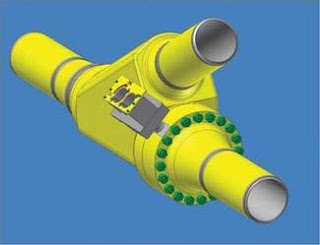Piggable wyes have been used extensively in
deepwater oil and gas pipeline operations to allow cleaning and inspection pigs
and intelligent pigs access through main lines and the laterals that tie into
them. Being able to run these state-of-the-art pigs through the wye improves the
operating efficiency and the long-term integrity of the pipeline system.
Although wyes improve operations on some levels, there are cases when operators
need to run pigs counter to the normal flow direction in the lines. This
presents no problem in a pipeline with no piggable wyes, but the internal
profile at the wye fitting juncture does not permit reverse flow pigging.
Quality Connector Systems (QCS) has developed
the Director Bi-Directional Wye to address this industry requirement.
Traditional
piggable wye operations
Operators of oil and gas pipelines wage a
constant battle against the harmful effects of internal corrosion, paraffin,
and condensate accumulation. Commonly accepted practice dictates that the
operator run pipeline pigs through the line. The pipeline product flow pushes
these cleaning devices through the length of the line. The pig maintains
contact with the internal wall of the pipe, pushing hydrates, paraffin,
condensate, and other potentially harmful agents in advance of its passage through
the pipeline. Corrosive elements are removed from the line at its termination
point, enhancing the long-term integrity of the pipeline.
Pigging a single line is a straightforward
process, requiring only that the pig be launched from one end and pushed the
length of the line using a liquid or gas medium as the propelling force until
it is captured in the pig receiver at the end of its journey. However, pigging
lateral line tie-in connections requires that the operator pre-plan the
installation of a piggable wye fitting in the main line during the construction
process. A piggable wye is a Y-shaped fitting that has two inlets, one for each
incoming pipeline, and a single outlet that merges the flow of the two
converging pipelines. The two lines converge in the Y at an intersecting angle
of 30°. This basic wye configuration was originally tested in the 1980s and has
proven to be a reliable design.
For years, the question has been whether it
would be feasible to run pigs backward through a wye from the outlet through
one of the inlets in a reverse flow pigging application. Until now, the answer
has been no.
The internal profile of the wye at the
juncture of the two pipelines would likely cause the pig stick in the fitting.
Alternatively, if the pig managed to traverse the juncture area of the wye,
there would be no way to determine which of the two converging pipelines the
pig would flow into.
Bi-directional
pigging
A recently developed product now allows pigs
to run forward or backward through a wye. The Director Wye has the unique
ability to accommodate reverse flow pigging. This new direction in piggable wye
technology uses an internal diverter sleeve that is actuated from the exterior
of the wye. The diverter can be actuated by an ROV or diver. The internal
diverter sleeve rotates within the mainline bore of the wye to direct the pig.






No comments:
Post a Comment